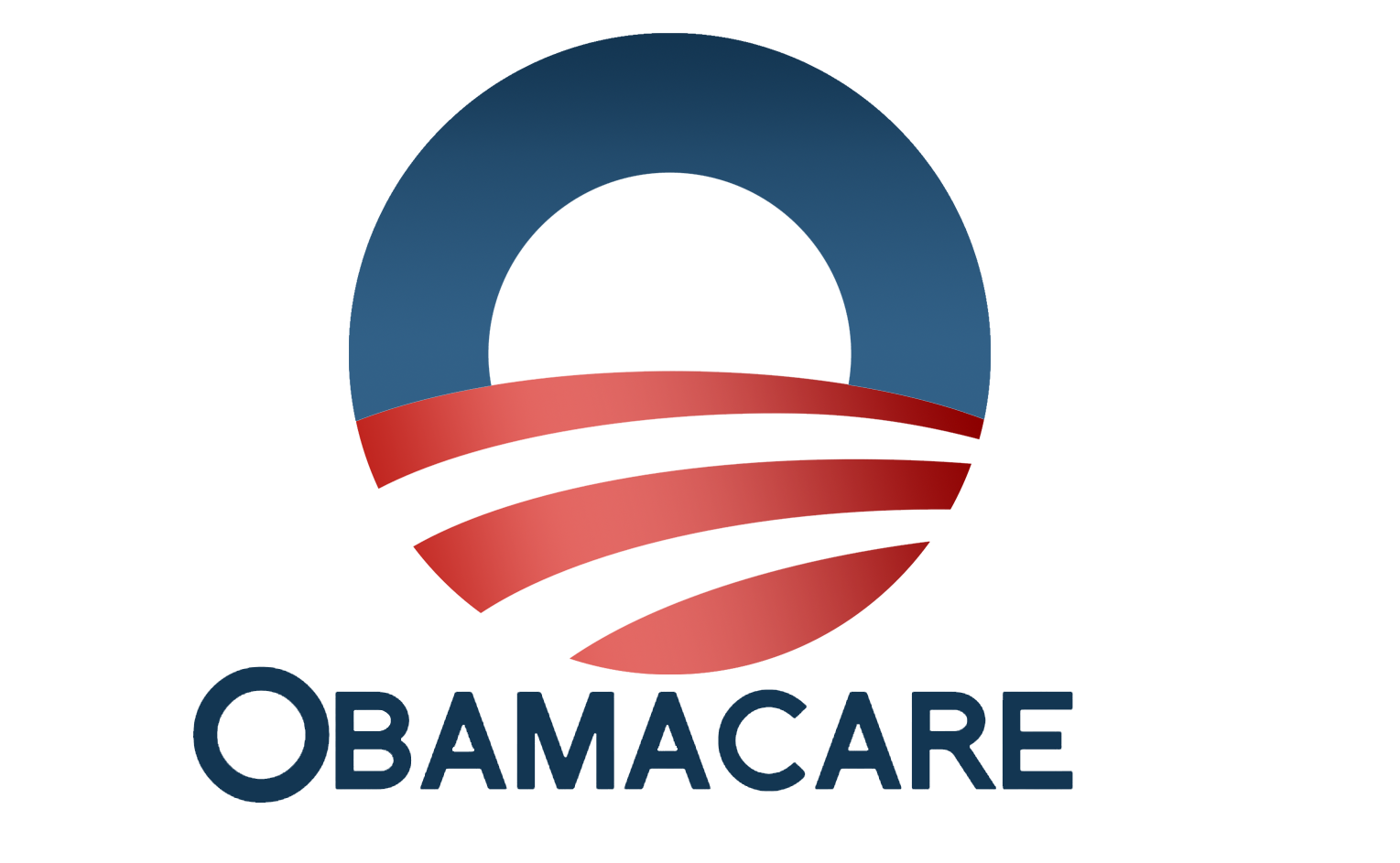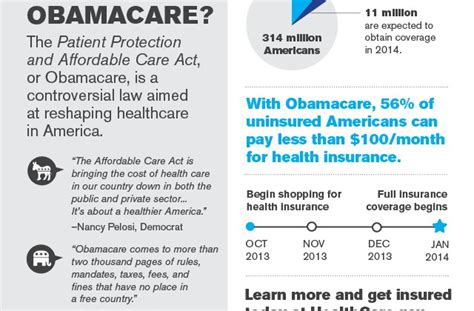Health Insurance Obamacare

The Affordable Care Act, popularly known as Obamacare, is a comprehensive healthcare reform legislation in the United States that has significantly impacted the nation's healthcare system and insurance landscape. Enacted in 2010, this landmark law aims to increase the quality and affordability of health insurance, reduce the number of uninsured Americans, and introduce various consumer protections. With its complex provisions and far-reaching effects, Obamacare has become a pivotal topic in healthcare discussions and a focus of ongoing debates.
Understanding the Core Principles of Obamacare

At its core, Obamacare operates on several key principles, including the individual mandate, health insurance marketplaces, and essential health benefits. The individual mandate requires most Americans to have qualifying health insurance coverage, with limited exemptions. This provision aims to ensure a broad pool of insured individuals, reducing risks and costs for insurers. Health insurance marketplaces, also known as exchanges, were established to provide a platform where individuals and small businesses can compare and purchase insurance plans, often with the benefit of federal subsidies for those meeting income criteria.
One of the most significant aspects of Obamacare is its guarantee of essential health benefits. These include ten broad categories of medical services that all health plans in the individual and small group markets must cover. These categories include ambulatory patient services, emergency services, hospitalization, maternity and newborn care, mental health and substance use disorder services, prescription drugs, rehabilitative and habilitative services and devices, laboratory services, preventive and wellness services, and pediatric services, including oral and vision care. This mandate ensures that all Americans, regardless of their income or health status, have access to a comprehensive set of health services.
Key Provisions and Their Impact
Obamacare introduced several consumer protections to improve the quality and accessibility of healthcare. For instance, it prohibits insurers from denying coverage to individuals with pre-existing conditions and allows young adults to remain on their parents’ plans until age 26. The law also eliminates annual and lifetime limits on essential health benefits and requires insurers to spend at least 80% of premium dollars on healthcare services and quality improvement.
Furthermore, Obamacare expanded Medicaid eligibility to include more low-income Americans. This expansion has significantly reduced the number of uninsured individuals in the U.S., particularly in states that have opted to participate. The law also established the Pre-Existing Condition Insurance Plan (PCIP) to provide coverage for individuals who have been denied coverage due to pre-existing conditions.
| Health Insurance Category | Impact of Obamacare |
|---|---|
| Individual Market | Increased access to affordable plans, especially for those with pre-existing conditions. Enhanced consumer protections and subsidies for lower-income individuals. |
| Small Group Market | Simplified enrollment process and standardized benefits. States have the flexibility to create their own small group market rules. |
| Medicaid | Expanded eligibility, covering more low-income individuals and families. States can opt into the expansion, which has led to significant increases in Medicaid enrollment. |

Enrollment and Plan Selection

Obamacare’s health insurance marketplaces, or exchanges, offer a wide range of plans from different insurers. These plans are categorized into metal tiers based on the expected percentage of costs covered: Bronze (60%), Silver (70%), Gold (80%), and Platinum (90%). Consumers can choose a plan that best suits their needs and budget. During the open enrollment period, typically from November to December, individuals can enroll in a new plan or make changes to their existing coverage. Outside this period, individuals can only make changes to their coverage if they experience a qualifying life event, such as marriage, birth of a child, or loss of other health coverage.
Navigating the Marketplace and Plan Benefits
Navigating the health insurance marketplace can be complex, especially with the variety of plans and options available. Consumers should consider several factors when selecting a plan, including the monthly premium, deductible, copayments, and out-of-pocket maximum. They should also assess the plan’s provider network to ensure their preferred doctors and hospitals are included. Obamacare plans must cover the ten essential health benefits, but the specific services covered within these categories can vary by plan.
| Plan Type | Coverage Details |
|---|---|
| Bronze Plans | Lowest monthly premiums but highest out-of-pocket costs. Typically suited for young, healthy individuals who rarely need medical care. |
| Silver Plans | Balanced option with moderate premiums and out-of-pocket costs. Silver plans are often paired with a cost-sharing reduction (CSR) plan, which reduces out-of-pocket costs for eligible individuals. |
| Gold Plans | Higher monthly premiums but lower out-of-pocket costs. Gold plans are suitable for individuals who anticipate frequent medical care or require specialized treatments. |
| Platinum Plans | Highest monthly premiums and lowest out-of-pocket costs. Platinum plans are ideal for those who need extensive medical care and want minimal out-of-pocket expenses. |
Cost-Sharing and Financial Assistance
Obamacare provides several mechanisms to make health insurance more affordable, especially for lower-income individuals. The law offers premium tax credits to reduce the monthly cost of insurance for those with household incomes between 100% and 400% of the federal poverty level. These credits are applied directly to the monthly premium, making insurance more affordable. Additionally, cost-sharing reductions (CSRs) are available to further reduce out-of-pocket costs for those with incomes below 250% of the federal poverty level.
Premium Tax Credits and CSRs: A Deeper Dive
Premium tax credits are advanced directly to the insurance company, lowering the monthly premium an individual pays. These credits are based on income and are designed to make insurance more affordable. For instance, if an individual’s expected income for the year is 200% of the federal poverty level, they would be eligible for a premium tax credit to reduce their premium costs. The credit amount is determined by the difference between the national average premium for a Silver plan and a percentage of the individual’s household income.
Cost-sharing reductions (CSRs) further lower out-of-pocket costs by reducing deductibles, copayments, and coinsurance. These reductions are available for Silver plans and are automatically applied to the plan if the individual is eligible. For example, a Silver plan with CSRs might have a lower deductible, meaning the individual pays less out of pocket before insurance coverage kicks in.
The Future of Obamacare: Challenges and Opportunities
Obamacare has faced numerous legal and political challenges since its inception. The most notable challenge was the National Federation of Independent Business v. Sebelius case, which questioned the constitutionality of the individual mandate. In 2012, the Supreme Court upheld the mandate, but subsequent legal battles and policy changes have continued to shape the law’s future.
Political and Legal Landscape
Political opposition to Obamacare has led to efforts to repeal or undermine the law. For instance, the removal of the individual mandate penalty in 2019 was seen as a significant blow to the law’s stability. However, the law has also garnered support, with many states opting to expand Medicaid coverage and implement their own insurance reforms. The ongoing debate around Obamacare’s future underscores the importance of healthcare policy and its impact on Americans’ lives.
Looking ahead, Obamacare's future remains uncertain but significant. The law has already transformed the healthcare landscape, making insurance more accessible and affordable for millions of Americans. With ongoing political and legal discussions, the law's trajectory will continue to be shaped, impacting the healthcare choices and experiences of Americans for years to come.
What is the individual mandate under Obamacare, and why is it important?
+
The individual mandate is a provision in Obamacare that requires most Americans to have qualifying health insurance coverage or pay a penalty. This mandate encourages healthy individuals to purchase insurance, which helps balance the risk pool and stabilizes premiums for everyone. It’s a key component in making the insurance market more sustainable and affordable.
How has Obamacare impacted the uninsured rate in the U.S.?
+
Obamacare has significantly reduced the number of uninsured Americans. The law’s combination of insurance mandates, consumer protections, and expanded Medicaid eligibility has made health insurance more accessible and affordable. As a result, the uninsured rate has dropped, particularly in states that have opted into the Medicaid expansion.
What are the essential health benefits under Obamacare, and why are they important?
+
Essential health benefits are a set of ten broad categories of medical services that all health plans in the individual and small group markets must cover. These categories include emergency services, hospitalization, maternity care, prescription drugs, and more. This mandate ensures that all Americans have access to a comprehensive set of health services, regardless of their income or health status.



